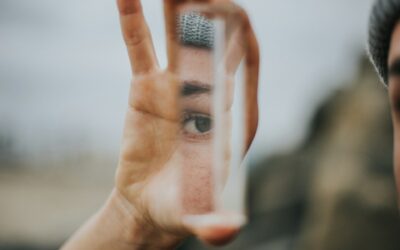This is a two-part series discussing what glaucoma is, the different types of glaucoma, and the various treatment options for glaucoma. The first part, here, will focus on basic anatomy and defining what glaucoma is. Stay tuned for the second part describing the different types of glaucoma and various treatment options for glaucoma.
Anatomy Review
The eye can be sectionalized into two major areas—the anterior half and the posterior half.
The anterior half consists of things we can see—the clear cornea (the front most structure you can touch), the iris (the colored part of the eye), the pupil, the lens, and the ciliary body.
The posterior half consists of a Jell-O like substance called vitreous humor and the retina.
We’ll discuss the important parts of the anterior chamber first, starting with the ciliary body.
It is important that the eye is transparent—this allows for light to be transmitted through the eye unobstructed to allow for clear vision. The ciliary body is a structure that produces a liquid called aqueous humor.
Aqueous humor is a clear, water-like substance that contains nutrients to supply the anterior structures of the eye with nutrition, since the anterior chamber of the eye does not contain many blood vessels.
Aqueous humor is also responsible for our eye pressure—called intraocular pressure or IOP. Generally speaking, we want our eye pressure to be somewhere between 12-22 mmHg. This keeps our eye inflated as well as permits proper flow of aqueous into the eye and metabolic wastes out of the eye into the venous drainage system.
Aqueous humor in the anterior aspect of the eye differs from the vitreous humor in the posterior chamber of the eye as the aqueous humor is constantly being produced and recycled throughout the anterior chamber, whereas the vitreous humor is not. The vitreous humor we are born with is the same vitreous humor that we die with.
Therefore, vitreous humor does not play a large role in our intraocular pressure. Its main role in our eye’s anatomy is to provide structural support and help with shock absorption.
The retina is what contains essentially the most important part of the eye—the photoreceptors and optic nerve.
Photoreceptors are specialized cells that detect light. After being stimulated by light, photoreceptors send a signal to the brain for interpretation and processing to create a visual image (sight) through a series of cell connections.
Photoreceptors send their signal to Bipolar cells who then transmit the signals to Ganglion cells who have axonal extensions (think about a thin little wire coming out of a lamp) that transmit the signal to the brain.
The optic nerve is a conglomeration of all the ganglion cells axons across the retina into one chunky “wire”. This allows all of the millions of axons to pass through one single hole from the eye to the brain.
You can visualize this by thinking about several hundred pieces of thread being pulled through a ring. As the treads are pulled through, you’ll note that the threads tend to stay around the edges of the ring and the center of the ring remains hollow.
A healthy optic nerve looks the same way. The hollow center area is called the “cup” of the nerve. Everyone is born with a unique optic nerve, the ratio of the axonal area (the disc) to the hollowed center (the cup) is referred to as the “cup to disc ratio”.
The average cup to disc ratio is about 0.3/0.3. This means the cup is about 1/3 the size of the overall nerve in a perfect circle.
Some individuals may have a more oval-shaped nerve where the cup-to-disc ratio numbers may be different, for example 0.3/0.4. Others may have a smaller cup–to–disc ratio (0.2/0.2) or a larger cup–to–disc ratio (0.6/0.6).
Eye doctors look at your optic nerve every year and compare it over time. You may be born with a smaller or larger nerve and that is okay! What your doctor is watching for, however, is changes to nerve size over time.
What we do not want to see is a nerve going from 0.3/0.3 to 0.6/0.8, as this could indicate axonal death.
Another way to visualize this would be that the average, healthy optic nerve looks like a donut. If there is optic nerve damage and axonal death, the “donut” will start to look more like an onion ring—we do not want this!
Death of axons, if in significant amounts, can cause visual field defects (absence of vision in a given area of your vision), as the signal from a given area in your retina is essentially “cut off” (the axons carrying the information from that area have died).
Unfortunately, once axons die they cannot be regenerated. Therefore, visual field defects as a direct result of axonal death are permanent.
Glaucoma is a Disease
When we think of glaucoma, we often think of it as a disease of too high of eye pressure. While this can be an associated finding with the disease, this is not always the case.
Glaucoma is actually a disease of the optic nerve in which axons die and the cup enlarges, it is associated with visual field defects, and if left untreated, can lead to blindness.
There are many different factors that go into why the optic nerve dies—one of which is increased eye pressure.
When eye pressure is too high, it compresses the structures of the eye—including the optic nerve. Constant pressure over extended periods of time essentially compresses the nerve and causes axonal death, and hence glaucoma.
Due to this association with eye pressure, the first route of treatment for glaucoma patients is often to lower pressure using eye drops or surgery.
Risk Factors of Glaucoma
There are several risk factors for glaucoma—however just because you meet these criteria does not necessarily mean you have glaucoma. It does mean that you should be on high alert and have a discussion with your eye doctor about a plan to monitor for the disease as glaucoma is a serious condition.
In fact, glaucoma is the second leading cause of blindness in the world. Therefore, yearly eye examinations to evaluate optic nerve health are essential for helping to detect the disease in its early stage and implementing treatment early on to prevent progression of the disease.
What is so dangerous about glaucoma is that it is typically a painless, asymptomatic, progressive disease. Many individuals (up to 50%) are unaware they have glaucoma. Symptoms of glaucoma typically do not arise until moderate stages in which visual field defects are already present.
Knowing this, here are some of the risk factors associated with the disease:
Age: Above 60 years old
Race: African American, Hispanic, and Asian
Family History: Having any family history puts up warning flags to your doctor, however risk is even greater if one of your siblings has been diagnosed with glaucoma.
Systemic Health Problems: Diabetes, Sleep Apnea, Raynaud’s Syndrome, Frequent Migraines, Hypertension, Hypotension, and Hypothyroidism all have increased risk of glaucoma development
Medications: Chronic Steroid Use (eye drops or systemic)
Ocular Findings: Large optic nerves and thin corneas
Testing for Glaucoma
Since glaucoma is a disease of the optic nerve, the optic nerve must be evaluated when diagnosing and monitoring progression of the disease.
In order for your eye doctor to visualize and evaluate the optic nerve he or she will conduct a variety of tests including a dilated fundus exam, OCT scans, Visual Field Testing, Pachymetry, and of course, IOP measurement.
A dilated fundus exam involves your doctor instilling dilation drops into your eyes. These drops make the pupil of the eye large so that your doctor can use a series of light systems and magnifying lenses to look into the back of the eye and visualize the retina and optic nerve.
While many individuals dislike dilation—it temporarily makes your vision a little fuzzy, inhibits accommodation (the process that allows us to view objects up close), and may make you more light sensitive—it is arguably the most important part of diagnosing and monitoring glaucoma as it allows the doctor to directly view your optic nerve.
Next, an OCT (optical coherence topography) scan is done of your optic nerve. An OCT is a special machine that uses light-waves to create a cross-sectional image of the various layers of the retina and optic nerve.
OCT imaging gives your doctor further scans and information to monitor for more subtle changes in retinal thickness, axonal thickness, etc. that are invisible to the naked eye.
Visual Field testing is used to quantify what you are seeing to the doctor. A stimulus of a small, bright light is shown across a dark screen. You are asked to click a button each time you see the light. It is not a particularly fun test to take, but it is extremely important for the monitoring of your condition.
When the stimulus is not seen in the same spot several different times, it could indicate a visual field defect. As mentioned before, visual field defects are created when axons corresponding to that particular area of your vision have died, and thus new defects are associated with advancing disease.
Pachymetry is a measurement of the thickness of your cornea. While this test does not directly affect the optic nerve, it is an important measurement to know as thin corneas have a higher risk factor of glaucoma.
Eye pressure (IOP) is measured in various different manners—the “air puff test” (Non-contact tonometer), Goldmann Applanation tonometry (the blue light probe that comes close to your eye), iCare Tonometer, and Perkins hand-held tonometer are some of the more common methods of IOP measurement.
Eye pressure is taken at every eye exam and monitored over time. High eye pressure every now and again may not be indicative of glaucoma, however prolonged time of increased pressure is something your doctor will most definitely watch for closely.
If one of these tests is abnormal, it is does not necessarily mean you have glaucoma. Your eye doctor will look at all of the test results, analyze the numbers, the appearance of the nerve, and decide how to best move forward from there.
In many cases, simply monitoring the nerve is ample “treatment”. In others, eye drops or surgery may be needed to prevent further progression. These treatment options will be discussed in more detail in part 2 of this series.
Types of Glaucoma
As mentioned before, not all types of glaucoma are a result of high eye pressure. There are various different types and thus, various different causes and methods of treatment.
The four main types of glaucoma are: Primary Open Angle Glaucoma (POAG), Secondary Glaucoma, Juvenile Glaucoma, and Congenital Glaucoma.
We’ll dive deeper into these different types in Part 2 of this series, as well has discuss some of the different treatment options of glaucoma, so be sure to check back soon to learn more!





